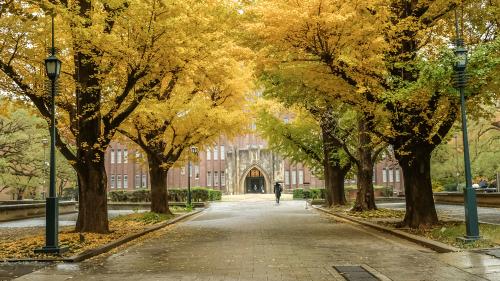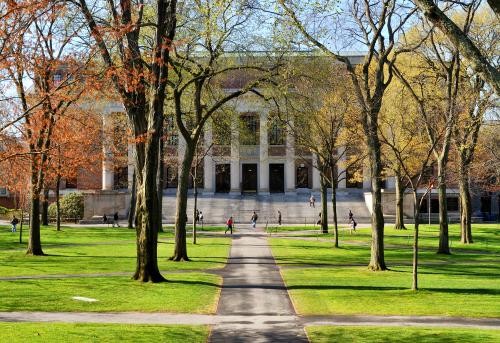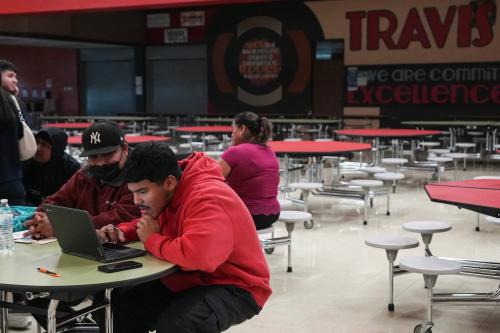A four-year college degree continues to be the best bet for an economically secure future for young people in the United States. However, for most families and prospective college students, understanding which colleges are accessible and affordable is a real struggle. On May 9, 2022, the Center on Children and Families at Brookings hosted an event analyzing some of the thorniest issues in higher education and what to do about them. Phillip Levine, Katharine Coman and A. Barton Hepburn Professor of Economics at Wellesley College, author of A Problem of Fit: How the Complexity of College Pricing Hurts Students – and Universities, and founder and CEO of MyinTuition.org (a quick-cost estimator for college) discussed how much college really costs for students from families with different incomes and assets, and how to make college more affordable for students from lower-income backgrounds.
Joy St. John, Dean of Admission and Financial Aid at Wellesley College, and soon to be Director of Admissions at Harvard University, gave the practitioners viewpoint on the role of financial aid.
Lindsay Page, Annenberg Associate Professor of Education Policy at Brown University discussed insights informed by her research on policies to improve college access and success for students, particularly those who would be the first in their families to reach post-secondary education.
Sandy Baum, nonresident fellow in the Center on Education Data and Policy at the Urban Institute and co-author of the new book Can College Level the Playing Field? Higher Education in an Unequal Society, discussed the difficulties lower-income students face becoming college-ready.
Levine made two main points. First, the financial aid system is so complex, that students have no idea what they will actually be charged. Because of the complexity, most people do not know that the sticker price of education decried in the media is not the price most families will pay. The only students who pay the full price at most private institutions are those from families with incomes at the 90th percentile of the income and asset distribution – over $200,000 in annual income and having typical assets for families with that income level. This makes it difficult for students and families to understand the choices available to them, hindering their ability to make the best decision for them.
Second, Levine documented that even though most families do not pay the sticker price, the price they are asked to pay often is still far too high for students from lower-income families. His research provides estimates of what different types of families would pay at different types of four-year, residential institutions (the focus of his analysis). These include “High Endowment Private,” “Public Flagship/R1,” “Other Private,” and “Other Public.” Only at highly endowed private institutions are lower-income students charged an affordable price. Many of them have financial aid policies that “meet full need.”
The figure below summarizes the results. It reports the calculated value of the “expected family contribution (EFC)”, which roughly corresponds to what families at different positions in the income and asset distribution can “afford” to pay (recognizing the obvious ambiguity in the definition of “afford”). Those values are compared to the amount that students are actually expected to pay, which includes an expected student loan and work-study funding along with the family’s direct cash payment. This value is called the net price. If a school charged families what they could afford, then we would see families’ net price on the line labelled “meets full need.” The other lines show how much the different types of institutions ask families at different income and asset levels to actually pay.
The results show that high endowment private institutions charge the lowest prices to the lowest income families, more or less in line with the amount they can “afford” to pay. The amount families are asked to pay at those institutions rises steeply with what families can afford to pay. For all other types of schools, though, lower income families are asked to pay considerably more than they can “afford.” The message here is clear: for the vast majority of lower-income students who do not enroll in the small number of highly selective, highly endowed private colleges, they will be faced with a price that they cannot afford to pay.
 Levine concluded his discussion by offering preferred solutions to complexity and to make college more affordable for lower-income students. First, he supported providing students with simplified information on what college will cost them – a price that is specific to their family’s finances – early in the process so that students and their families understand that the sticker price is not their price. Second, he strongly supports doubling the maximum Pell Grant – the federal grant available to students from low-income families – whose current value in 2022-2023 is $6,895. That would fill the gap for these students who are expected to pay more in college costs than they are estimated to be able to afford. Closing that gap is critical.
Levine concluded his discussion by offering preferred solutions to complexity and to make college more affordable for lower-income students. First, he supported providing students with simplified information on what college will cost them – a price that is specific to their family’s finances – early in the process so that students and their families understand that the sticker price is not their price. Second, he strongly supports doubling the maximum Pell Grant – the federal grant available to students from low-income families – whose current value in 2022-2023 is $6,895. That would fill the gap for these students who are expected to pay more in college costs than they are estimated to be able to afford. Closing that gap is critical.
The discussion then turned to the other panelists, who provided their perspectives on other constraints in the higher education market that reduce college access. Joy St. John noted that admissions and financial aid officers face constraints in who they admit and how much financial aid the institution can offer them. “You’re also driven as a financial aid professional by using aid as a way to help the college meet its enrollment goals.” These include the need to satisfy a focus on equity across students, the desire to fill a class with students that meet broader institutional priorities, and to generate sufficient revenue to operate the institution.
Lindsay Page pointed out, “the college process overall is enormously complex that students and their families go through a handful of times at most … because of the complexity and the many steps there is just lots of room for error.” She drew her comments from her past research on the complexities of the college-going process that go beyond price. Students and their parents have very little experience navigating the system and often need help. This is particularly true for first generation students. The inadequate number of high school counselors contributes to this problem.
Sandy Baum noted, “if we really want to understand how to create better college opportunities for students, we have to look at what is happening to them earlier in their lives.” Her work points out that our discussions about college access take place against a backdrop of vast inequality. She highlighted the limitations of our early childhood and K-12 education system and the extent to which it hinders the ability of the higher education system to generate social mobility, topics covered in her new book, Can College Level the Playing Field? Higher Education in an Unequal Society. Students have experienced very different life circumstances by the time they turn 18, which affects their ability to enroll in and succeed in college. Higher education can only maximize its potential to help those students if we address the inequalities they face before they get there.
The Brookings Institution is financed through the support of a diverse array of foundations, corporations, governments, individuals, as well as an endowment. A list of donors can be found in our annual reports published online here. The findings, interpretations, and conclusions in this report are solely those of its author(s) and are not influenced by any donation.








Commentary
A problem of fit: Tackling affordability and pricing in higher education
May 16, 2022